
| SELECT A COUNTRY/REGION |

|
Social Applications
Networks
Knowledge Base
Support
|

|
C-Level Executives
Other Roles
|

|
Support
Education
Partner
Other Tasks
|
-
-
-
-
- Downloads
- Database
- Oracle Fusion Middleware
- Oracle Enterprise Manager
- Developer Tools
- Java
- See All …
- Discussion Forums
- Database and SQL
- Oracle Fusion Middleware
- Oracle Enterprise Manager
- Developer Tools
- Technology Network Feedback
- See All …
-
Lesson 1: Socket Communications
|
Lesson 1: Socket Communications
[ <<BACK] [ CONTENTS] [ NEXT>>]
Java Programming Language Basics, Part 1, finished with a simple network communications example using the Remote Method Invocation (RMI) application programming interface (API). The RMI example allows multiple client programs to communicate with the same server program without any explicit code to do this because the RMI API is built on sockets and threads.
This lesson presents a simple sockets-based program to introduce the concepts of sockets and multi-threaded programming. A multi-threaded program performs multiple tasks at one time such as fielding simultaneous requests from many client programs.
- What are Sockets and Threads?
- About the Examples
- Example 1: Server-Side Program
- Example 1: Client-Side Program
- Example 2: Multithreaded Server Example
- More Information
Note: See Creating a Threaded Slide Show Applet for another example of how multiple threads can be used in a program.
| |
What are Sockets and Threads?
A socket is a software endpoint that establishes bidirectional communication between a server program and one or more client programs. The socket associates the server program with a specific hardware port on the machine where it runs so any client program anywhere in the network with a socket associated with that same port can communicate with the server program.
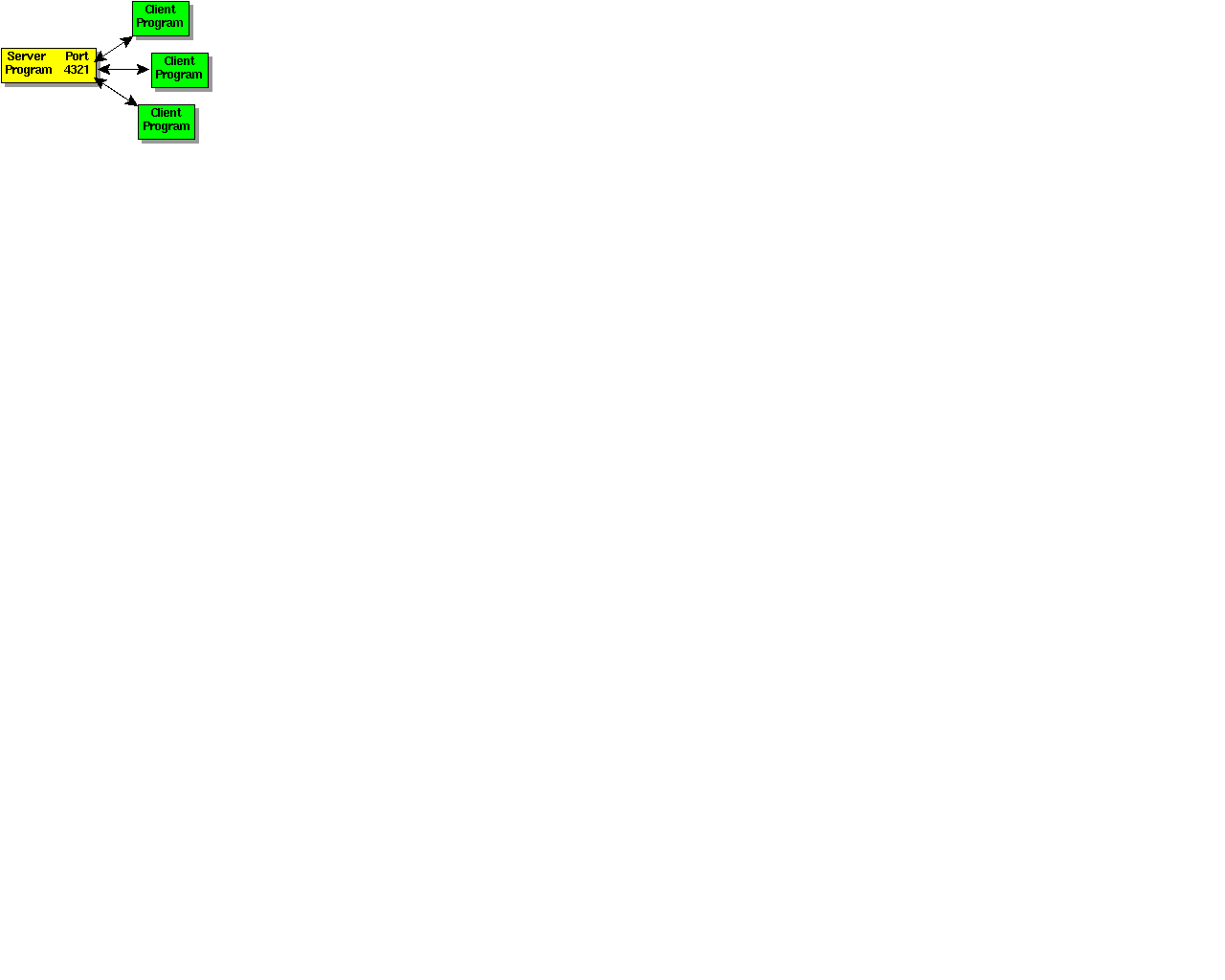 A server program typically provides resources to a network of client
programs. Client programs send requests to the server program, and the
server program responds to the request.
A server program typically provides resources to a network of client
programs. Client programs send requests to the server program, and the
server program responds to the request.
One way to handle requests from more than one client is to make the server program multi-threaded. A multi-threaded server creates a thread for each communication it accepts from a client. A thread is a sequence of instructions that run independently of the program and of any other threads.
Using threads, a multi-threaded server program can accept a connection from a client, start a thread for that communication, and continue listening for requests from other clients.
About the Examples
The examples for this lesson consist of two versions of the client and server program pair adapted from the FileIO.java application presented in Part 1, Lesson 6: File Access and Permissions.
Example 1 sets up a client and server communication between one server program and one client program. The server program is not multi-threaded and cannot handle requests from more than one client.
Example 2 converts the server program to a multi-threaded version so it can handle requests from more than one client.
Example 1: Client-Side Behavior
The
client program presents a simple user interface and prompts for text input. When you click the
Click Me
button, the text is sent to the server program. The client program
expects an echo from the server and prints the echo it receives on its
standard output.
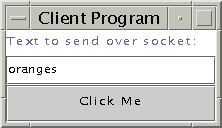
Example 1: Server-Side Behavior
The
server program presents a simple user interface, and when you click the
Click Me button, the text received from the client is displayed. The server echoes the text it receives whether or not you click the
Click Me button.
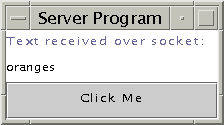
Example 1: Compile and Run
To run the example programs, start the server program first. If you do not, the client program cannot establish the socket connection. Here are the compiler and interpreter commands to compile and run the example.
javac SocketServer.java javac SocketClient.java java SocketServer java SocketClient |
Example 1: Server-Side Program
The
server program establishes a socket connection on Port 4321 in its
listenSocket method. It reads data sent to it and sends that same data back to the server in its
actionPerformed method.
listenSocket Method
The
listenSocket method creates a
ServerSocket
object with the port number on which the server program is going to
listen for client communications. The port number must be an available
port, which means the number cannot be reserved or already in use. For
example, Unix systems reserve ports 1 through 1023 for administrative
functions leaving port numbers greater than 1024 available for use.
public void listenSocket(){
try{
server = new ServerSocket(4321);
} catch (IOException e) {
System.out.println("Could not listen on port 4321");
System.exit(-1);
}
|
listenSocketSocketserver.acceptSocket
try{
client = server.accept();
} catch (IOException e) {
System.out.println("Accept failed: 4321");
System.exit(-1);
}
|
listenSocketBufferedReaderclientPrintWriter
try{
in = new BufferedReader(new InputStreamReader(
client.getInputStream()));
out = new PrintWriter(client.getOutputStream(),
true);
} catch (IOException e) {
System.out.println("Read failed");
System.exit(-1);
}
}
|
listenSocket
while(true){
try{
line = in.readLine();
//Send data back to client
out.println(line);
} catch (IOException e) {
System.out.println("Read failed");
System.exit(-1);
}
}
|
actionPerformed Method
The
actionPerformed method is called by the Java platform for action events such as button clicks. This
actionPerformed method uses the text stored in the
line object to initialize the
textArea object so the retrieved text can be displayed to the end user.
public void actionPerformed(ActionEvent event) {
Object source = event.getSource();
if(source == button){
textArea.setText(line);
}
}
|
Example 1: Client-Side Program
The
client program establishes a connection to the server program on a particular host and port number in its
listenSocket method, and sends the data entered by the end user to the server program in its
actionPerformed method. The
actionPerformed method also receives the data back from the server and prints it to the command line.
listenSocket Method
The
listenSocket method first creates a
Socket object with the computer name (
kq6py) and port number (4321) where the server program is listening for client connection requests. Next, it creates a
PrintWriter object to send data over the socket connection to the server program. It also creates a
BufferedReader object to read the text sent by the server back to the client.
public void listenSocket(){
//Create socket connection
try{
socket = new Socket("kq6py", 4321);
out = new PrintWriter(socket.getOutputStream(),
true);
in = new BufferedReader(new InputStreamReader(
socket.getInputStream()));
} catch (UnknownHostException e) {
System.out.println("Unknown host: kq6py");
System.exit(1);
} catch (IOException e) {
System.out.println("No I/O");
System.exit(1);
}
}
|
actionPerformed Method
The
actionPerformed method is called by the Java platform for action events such as button clicks. This
actionPerformed method code gets the text in the
Textfield object and passes it to the
PrintWriter object, which then sends it over the socket connection to the server program.
The
actionPerformed method then makes the
Textfield
object blank so it is ready for more end user input. Lastly, it
receives the text sent back to it by the server and prints the text
out.
public void actionPerformed(ActionEvent event){
Object source = event.getSource();
if(source == button){
//Send data over socket
String text = textField.getText();
out.println(text);
textField.setText(new String(""));
out.println(text);
}
//Receive text from server
try{
String line = in.readLine();
System.out.println("Text received: " + line);
} catch (IOException e){
System.out.println("Read failed");
System.exit(1);
}
}
|
Example 2: Multithreaded Server Example
The example in its current state works between the server program and one client program only. To allow multiple client connections, the server program has to be converted to a multithreaded server program.
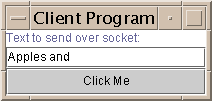
First Client
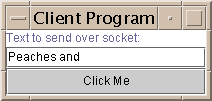
Second Client

Third Client
|
 |
In this example the
listenSocket method loops on the
server.accept call waiting for client connections and creates an instance of the
ClientWorker class for each client connection it accepts. The
textArea component that displays the text received from the client connection is passed to the
ClientWorker instance with the accepted client connection.
public void listenSocket(){
try{
server = new ServerSocket(4444);
} catch (IOException e) {
System.out.println("Could not listen on port 4444");
System.exit(-1);
}
while(true){
ClientWorker w;
try{
//server.accept returns a client connection
w = new ClientWorker(server.accept(), textArea);
Thread t = new Thread(w);
t.start();
} catch (IOException e) {
System.out.println("Accept failed: 4444");
System.exit(-1);
}
}
}
|
The important changes in this version of the server program over the non-threaded server program are the
line and
client variables are no longer instance variables of the server class, but are handled inside the
ClientWorker class.
The
ClientWorker class implements the
Runnable interface, which has one method,
run. The
run method executes independently in each thread. If three clients request connections, three
ClientWorker instances are created, a thread is started for each
ClientWorker instance, and the
run method executes for each thread.
In this example, the
run
method creates the input buffer and output writer, loops on the input
stream waiting for input from the client, sends the data it receives
back to the client, and sets the text in the text area.
class ClientWorker implements Runnable {
private Socket client;
private JTextArea textArea;
//Constructor
ClientWorker(Socket client, JTextArea textArea) {
this.client = client;
this.textArea = textArea;
}
public void run(){
String line;
BufferedReader in = null;
PrintWriter out = null;
try{
in = new BufferedReader(new
InputStreamReader(client.getInputStream()));
out = new
PrintWriter(client.getOutputStream(), true);
} catch (IOException e) {
System.out.println("in or out failed");
System.exit(-1);
}
while(true){
try{
line = in.readLine();
//Send data back to client
out.println(line);
//Append data to text area
textArea.append(line);
}catch (IOException e) {
System.out.println("Read failed");
System.exit(-1);
}
}
}
}
|
JTextArea.appendJTextArea.appendtextArea.append(line)synchronizedruntextArea.append(line)appendText(line) public synchronized void appendText(line){
textArea.append(line);
}
synchronizedtextAreatextAreaThe
finalize()
method is called by the Java virtual machine (JVM)* before the program
exits to give the program a chance to clean up and release resources.
Multi-threaded programs should close all Files and
Sockets they use before exiting so they do not face resource starvation. The call to
server.close() in the
finalize() method closes the
Socket connection used by each thread in this program.
protected void finalize(){
//Objects created in run method are finalized when
//program terminates and thread exits
try{
server.close();
} catch (IOException e) {
System.out.println("Could not close socket");
System.exit(-1);
}
}
|
More Information
You can find more information on sockets in the All About Sockets section in The Java Tutorial.
[ TOP]
|
Java SDKs and Tools
|
||
|
Java Resources
|
||






